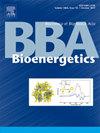残基D1/V185参与6803聚囊球菌和残余热聚球菌光系统II功能的新认识
IF 2.7
2区 生物学
Q2 BIOCHEMISTRY & MOLECULAR BIOLOGY
引用次数: 0
摘要
采用EPR和光学动力学方法研究了残留热聚球菌(原T. elongatus)和聚胞球菌6803的D1-V185T和D1-V185N突变对光系统II (PSII)的影响。EPR光谱揭示了两个突变体在高自旋构型(S2HS)和低自旋构型(S2LS)中存在S2态的混合物。与野生型的S2HS相比,D1-V185T突变体的S2HS状态在198 K时不会进展到S3状态。这种缺陷可能是由于质子化状态和Mn4CaO5簇周围的氢键网络的改变。光学研究表明,这些突变显著影响了s3到s0跃迁过程中的质子释放。虽然与TyrZ●形成相关的初始快速质子释放在我们测量的分辨率范围内不受影响,但第二次较慢的质子释放被延迟,这表明突变破坏了底物水有效去质子化所必需的氢键相互作用(O6)。这种质子转移的中断也与S3状态下较慢的水交换有关,可能是由于185位苏氨酸或天冬酰胺侧链引入的非天然氢键。这些发现表明D1-V185在调节质子转移动力学和水结合中起关键作用,强调了PSII结构和功能变化之间复杂的相互作用。本文章由计算机程序翻译,如有差异,请以英文原文为准。
New insights into the involvement of residue D1/V185 in photosystem II function in Synechocystis 6803 and Thermosynechococcus vestitus
The effects of D1-V185T and D1-V185N mutations in Photosystem II (PSII) from Thermosynechococcus vestitus (formerly T. elongatus) and Synechocystis 6803, respectively, were studied using both EPR and optical kinetics. EPR spectroscopy reveals the presence of a mixture of a S2 state in a high spin configuration (S2HS) and in a low spin configuration (S2LS) in both mutants. In contrast to the S2HS in the wild type, the S2HS state in the D1-V185T mutant does not progress to the S3 state at 198 K. This inability is likely due to alterations in the protonation state and hydrogen-bonding network around the Mn4CaO5 cluster. Optical studies show that these mutations significantly affect proton release during the S3-to-S0 transition. While the initial fast proton release associated with TyrZ● formation remains unaffected within the resolution of our measurements, the second, and slower, proton release is delayed, suggesting that the mutations disrupt the hydrogen-bonding interactions necessary for efficient deprotonation of substrate water (O6). This disruption in proton transfer also correlates with slower water exchange in the S3 state, likely due to non-native hydrogen bonds introduced by the threonine or asparagine side chains at position 185. These findings point to a critical role of D1-V185 in regulating both proton transfer dynamics and water binding, underscoring a complex interplay between structural and functional changes in PSII.
求助全文
通过发布文献求助,成功后即可免费获取论文全文。
去求助
来源期刊

Biochimica et Biophysica Acta-Bioenergetics
生物-生化与分子生物学
CiteScore
9.50
自引率
7.00%
发文量
363
审稿时长
92 days
期刊介绍:
BBA Bioenergetics covers the area of biological membranes involved in energy transfer and conversion. In particular, it focuses on the structures obtained by X-ray crystallography and other approaches, and molecular mechanisms of the components of photosynthesis, mitochondrial and bacterial respiration, oxidative phosphorylation, motility and transport. It spans applications of structural biology, molecular modeling, spectroscopy and biophysics in these systems, through bioenergetic aspects of mitochondrial biology including biomedicine aspects of energy metabolism in mitochondrial disorders, neurodegenerative diseases like Parkinson''s and Alzheimer''s, aging, diabetes and even cancer.
 求助内容:
求助内容: 应助结果提醒方式:
应助结果提醒方式:


